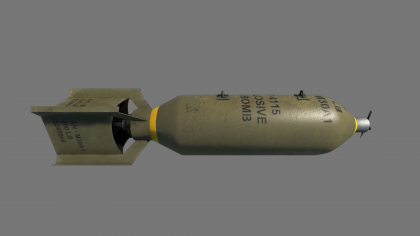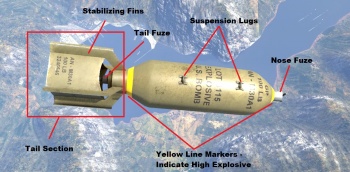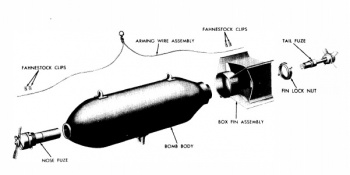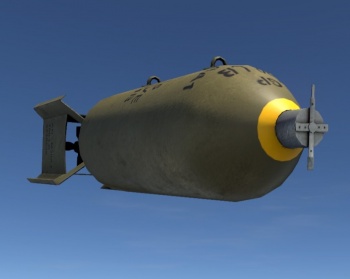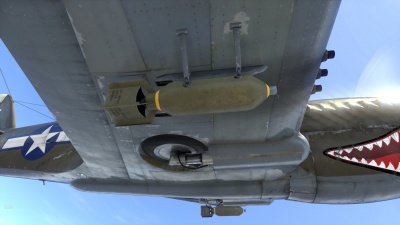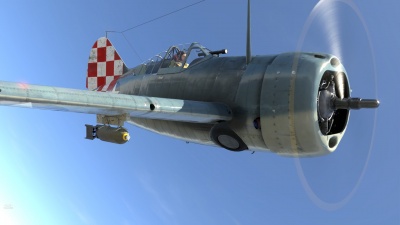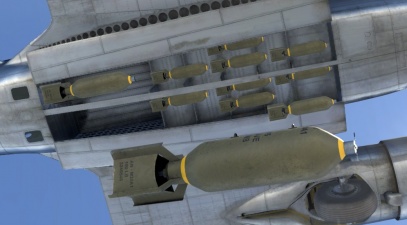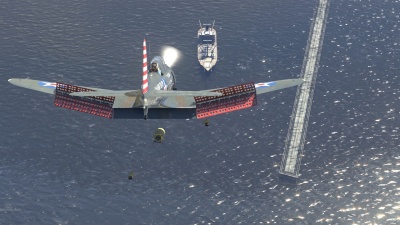AN-M30A1 (100 lb)
Contents
Description
The AN-M30A1 (100 lb) is an American general-purpose high explosive (HE) bomb.
The AN-M30A1 is an air-dropped bomb which utilises a combination of blast damage, penetration and fragmentation during its explosive effect. Typically the general-purpose bombs are used when targeting either enemy troops, vehicles and buildings.
The AN-M30A1 utilises two types of fuses to detonate the bomb with the nose fuse which is the main fuse and the one in the tail as a backup. General-purpose bombs are aerodynamic in shape and have stabilising fins to enable accurate drop locations when sighted, targeted and released by a bombardier. The aerodynamic effect also benefits aircraft which carry the bombs on external payload pylons.
Vehicles equipped with this weapon
| Vehicles equipped with this weapon | |
|---|---|
| Fighters | |
| BF2C | BF2C-1 |
| F2A | F2A-3 |
| F3F | F3F-2 · Galer's F3F-2 |
| F4F | F4F-3 · F4F-4 |
| F4U | F4U-4 |
| Hawk | Hawk III |
| P-26 | P-26A-33 · P-26A-34 · P-26A-34 M2 · P-26B-35 |
| P-40 | P-40E-1 · P-40E-1 TD · ␗P-40E-1 · ▄P-40F-5 Lafayette · P-40F-10 |
| P-51 | P-51A · J26 David · P-51C-10 · ␗P-51C-11-NT · P-51D-5 · P-51D-10 · P-51H-5-NA |
| Jet fighters | F9F-2 · F9F-5 |
| Strike aircraft | |
| A-26 | A-26B-10 · A-26B-50 |
| A-36 | A-36 |
| F-84 | F-84B-26 · F-84G-21-RE · ␗F-84G-21-RE · ▄F-84G-21-RE · ▄F-84G-26-RE · ␗F-84G-31-RE |
| PBJ-1 | PBJ-1H · PBJ-1J |
| XA-38 | XA-38 |
| Bombers | |
| A-26 | A-26C-45 · A-26C-45DT |
| A-29 | A-29 · ▄Hudson Mk V |
| B-18 | B-18A |
| B-24 | B-24D-25-CO |
| B-25 | B-25J-1 · B-25J-20 · ␗B-25J-30 |
| B-26 | B-26B · B-26C |
| OS2U | OS2U-1 · OS2U-3 |
| PB4Y | PB4Y-2 · ␗PB4Y-2 · ▄PB4Y-2 |
| PBM | PBM-1 "Mariner" · PBM-3 "Mariner" · PBM-5A "Mariner" |
| PBY-5 | PBY-5 Catalina · PBY-5A Catalina · ▄Catalina Mk IIIa · ▂PBY-5A Catalina · ▄PBY-5A Late |
| SB2U | SB2U-2 · SB2U-3 |
| SBD | SBD-3 |
| SOC | SOC-1 |
| TBD | TBD-1 |
| V-156 | V-156-B1 |
General info
| Bomb characteristics | |
|---|---|
| Mass | 49.9 kg (110 lbs) |
| Explosive mass | 24.5 kg |
| Explosive type | Amatol |
| TNT equivalent | 24.5 kg |
| HE max penetration | 65 mm |
| Armour destruction radius | 2 m |
| Fragment dispersion radius | 67 m |
This bomb was manufactured in one of three ways, either cast or spun as one piece, cast as two pieces and welded or cast as three pieces and welded. The nose contained a threaded opening which is closed by the fuse-seat liner and the male plug at the tail is closed by an explosive adapter booster.
The AN-M30A1 is outfitted with two suspension lugs which are directly welded to the bomb casing 14 inches apart. A single suspension lug is welded to the opposite side of the bomb at the centre of gravity which can be utilised to suspend from British aircraft.
This version of the AN-M30 bomb, the A1 version indicates that a modification which locks the base plate to the central filling via two steel pins, preventing the removal of the base plate once the bomb is filled with its explosive material. Once the adapter booster is inserted, a pin is inserted which prevents its withdrawal.
The tail section of the AN-M30A1 bomb is a cast-steel sleeve known as a box-type tail. The Sleeve is manufactured of a cast-steel sleeve with four sheet-steel fins held into place with a locking nut. Each fin is held by a fin-strut which once in place are welded together to make one assembly. Different tail fins were utilised when the low-altitude bombing took place compared to higher altitude bombing.
The impact nose fuse is vane operated and delayed armed meaning that when the bomb is dropped, the vane spins, arming the bomb away from the plane dropping it. After arming, the bomb will detonate when the impact fuse comes in contact with an object. Detonation can be set to be instantaneous when the bomb hits something or with a delay, allowing the bomb to burrow into the ground before detonating. The impact tail fuse is also vane armed and can be set to delayed detonation. Tail fuses are typically used with nose fuses as a backup detonator in case the primary fails.
The AN-M30A1 was painted with a standard colour scheme since 11 March 1942; the body was painted olive drab while yellow stripes were added to indicate the bomb was a HE. To differentiate what type of filler was used, a one-inch yellow band at the nose and tail along with a 1/4 inch dotted band at the centre of gravity of the bomb which indicated it was filled with 50/50 Amatol or TNT fillers. A second yellow band was added to the nose and tail of the bomb if it was filled with Composition"B" which required special handling due to its sensitivity. Standard marking on the bomb body in black paint included type, weight, the name of the bomb, type of filling, lot number, date and place of filling along with the inspector's initials. Indestructible markings of this information were also stamped into the casing before filling with explosives.
Effective damage
The AN-M30A1 utilised Amatol as its explosive compound which is a composition of TNT (Trinitrotoluene C7H5N3O6) and Ammonium Nitrate (N2H4O3). Amatol is a British name which comes from the words of the ingredients of this compound, Ammmonium and toluene. Supplies of TNT were limited due to the amount of ordnance needed to be manufactured. Because of the great explosive velocity and brisance of TNT, one-way stretch resources was to exploit TNT's one drawback. TNT in its pure form when detonated leaves a black smoke residue after it explodes due to the oxygen deficiency in TNT (does not fully explode/burn all components efficiently). To supplement TNT's need for oxygen, ammonium nitrate is added to the mixture which has an oxygen surplus and overall increases the energy release of a TNT explosion when mixed. When compared to each other, Amatol has a lower explosive velocity and brisance than pure TNT; however because it was cheaper to use Amatol, it became the go-to explosive for general purpose bombs.
Comparison with analogues
| Comparable bombs to AN-M30A1 (100 lb) | |||||||
|---|---|---|---|---|---|---|---|
| Name | Mass | Explosive mass | Explosive type | Penetration | Armour destruction radius | Fragmentation radius | |
| ▂ | FAB-50sv | 49 kg | 26.35 kg | TNT | 65 mm | 2 m | 73 m |
| ▀ | SC50JA | 50 kg | 25 kg | Fp.60/40 | 65 mm | 2 m | 70 m |
| ▅ | Type 97 Number 6 | 60 kg | 25.3 kg | Shimose | 65 mm | 2 m | 69 m |
| ▅ | Type 94 GPHE | 50 kg | 25.09 kg | Type 97 | 65 mm | 2 m | 70 m |
| ▄ | GP 50 | 58 kg | 25 kg | Amatol | 65 mm | 2 m | 70 m |
| ▄ | G.A.M.Mn 50 | 53 kg | 29 kg | M.Mn | 66 mm | 2 m | 75 m |
| ▄ | D.T. No.2 | 55.7 kg | 19 kg | TNT | 64 mm | 2 m | 62 m |
Usage in battles
The AN-M30A1 (100 lb) is a general purpose HE bomb which was utilised by fighters, attackers and bombers. Due to its size, either one or two could be outfitted to a fighter or attacker allowing it to perform low-level precision bombing on AAA or light vehicles. Bombers can carry between 12 to 16 of these bombs and could drop them all in one location bombing a base or could spread them out across the map depending on where the targets of opportunity are.
Pros and cons
Pros:
- Effective usage on light vehicles and soft targets
- Allows fighters to equip and perform low-level bombing runs
- In quantity can be effective against columns of vehicles from low-level bombing
Cons:
- Ineffective against hardened targets and large bases
- Usage against vehicles at higher altitudes provides time for vehicles to scatter
- Small destructive radius (3 m) against armoured vehicles
History
Early in aviation history, applications for aircraft to serve in a military capacity surfaced, not only with the intent to scout a battlefield from an aerial vantage point but for the possibility to drop explosive bombs too. Due to the frail nature of the early wood-frame and cloth covered aircraft, lifting capacity resulted in the ability to only carry small bombs. Effectively these early bombers were hailed as aerial artillery fire which could reach targets hundreds of miles further than the most powerful land-based cannons of the time. Prior to the war, contests abounded where pilots would drop oranges or flour sacks upon predesignated targets to see who could hit closes to the centre.
Italian aviators were the first to use bombs in a warfare capacity in 1912 during their campaign of Tripoli. These first bombs were conversions of existing cannon ammunition and were effective only against personnel as they did not provide a strong enough provision to damage hardened equipment or structures. As lifting capacity of aircraft increased, so did the ability for them to carry more and larger explosives.
For the United States, bomb design did not become a priority until the middle of 1917 when a French official came to the U.S. with several samples of the Gros Andreau bombs which the French were using in large quantities at that time. Immediately these bombs were accepted by the U.S. and used as a standard in developing the first three sizes to be implemented in the military. These three bombs were known as the early "Mark" series, 25 lb Mk.I demolition bomb, 50 lb Mk.I demolition bomb and the 100 lb Mk.I demolition bomb. By December 1917, only six months later, the military put forth requirements for the development of bombs larger than the existing 100 lb bomb. After two more months of development, production of demolition bombs up to 1,000 lbs was started. Rejected 3-inch artillery rounds were the basis for early 25 lb bombs which were modified into a streamlined shape, very similar to the British Cooper bombs of the time. Larger bombs were manufactured and filled with explosive filler, all of which were placed into a streamlined body, of which a cylindrical shape was the most advantageous.
Early on, the Mark series of bombs proved to be largely unsatisfactory in a number of different areas. The bomb body itself was weak due to the sheet metal it was made from and the number of welds needed to join the pieces together. The stabilizing fins were made of flimsy metal which tended to distort during both the handling and flight of the bomb, adversely affecting accuracy. For the field technicians, inserting the fuse was a complicated process which required removing the stabilizing fin structure potentially damaging the fins. The fuses tended to have a high fail rate and due to their design, they would instantly arm after release from the aircraft posing a direct to the delivery aircraft. Later modifications would eliminate many of the negative factors to include adding a nose fuse, time delaying arming of the fuse, strengthening of the stabilizing fins and adding primer detonators to ensure proper explosive train sequences. Other changes including streamlining all bomb bodies and utilising 100% T.N.T. as an explosive filler resulted in the newer "Modified Mark" series of Army bombs.
Prior to World War II, the military determined that the Modified Mark series of bombs were obsolete requiring newer and up-to-date bombs to be developed. Both the U.S. Army and Navy began development of their own series of bombs, the Army with the "M" series and the Navy with their "Mk" series. Both similar, these bombs were designed with parallel sides, an ogival nose and a boat tail which is a box type-tail reinforced to prevent warping and aid with accurate drops. Due to the shortage of T.N.T., the Army filled their bombs with 50/50 Amatol with T.N.T. ends to seal in the Amatol and protect it from moisture. The Navy, on the other hand, continued to manufacture their bombs with 100% T.N.T.
With the approach of World War II, the U.S. Army (including the Army Air Corps) and the Navy standardized their series of bombs allowing for interchanging between services, consolidating manufacturing capabilities and allowing for modifications which enabled British service aircraft to mount these bombs too. Even after the standardization of bombs in 1941, the standardization process went through a few phases of further refinement, the first of which changed all high-explosive bombs to be termed general purpose (G.P.) or general purpose high-explosive (G.P.H.E). Later the designation of demolition bomb would come back for a few specific bombs.
When bombs are dropped, there is always a chance that something in the explosive train of the bomb will fail and it will not explode. Early AN style bombs were defusable in the event they did not explode on contact, meaning that any unexploded AN bomb could have the fuses and boosters removed without the bomb exploding, rendering it inert. To counter this and allow for the potential "dud" bomb to explode when tampered with, the AN G.P.H.E. series bombs with the modification "A1" annotated that these bombs now had special pins mounted in the bomb's baseplate which fused with the explosive filler making it impossible to remove the booster without causing the bomb to detonate. Other modifications later added would include minor changes to the bomb body or the type of explosive filling used. During this time a second option for bomb tails was added, the box-type tail was already the mainstay of the bombs, however, to create a more aerodynamic bomb a conical tail assembly was added. This stretched out low profile tail improved the aerodynamics of the carrying aircraft, allowing it to carry more ordnance.
Progressing towards the Korean and Vietnam wars, piston-driven aircraft were giving way to jet fighters, bombers and attackers, many of which carried their ordnance on external pylons hung under the wing or underbelly. The new Mk 80 series bombs (Mk 81, 82, 83 and 84) were developed to keep external hung ordnance from creating too much drag on the delivery aircraft. Initially, the Mk 81 250 lb bombs were considered ineffective for their size or required a large amount to be effective and were removed from the munitions inventory. All-weather fighters and attackers were now being outfitted with the Mk series bombs and a new problem developed when it came to low-altitude attacks (typically coming in under low cloud cover) where the aircraft would deploy its ordnance which would hit the ground and explode catching the delivery aircraft in either the explosive blast or the shock-wave from the blast.
Modifications were developed to slow down or retard the flight of bombs, allowing for the delivery aircraft to depart out of the blast zone before they hit and detonated. Several options became available which allowed these bombs to remain aerodynamic low-drag while en-route to the target, but when deployed converted to high-drag, slower falling bombs. One option was to attach four bladed plates to the rear of the bomb so that when the bomb deployed, these plates would pop out and create high-drag to slow the fall. Another option was to use a ballute which was basically an airbag which deployed from the rear of the bomb that acted like a drogue chute, effectively causing high-drag. Later during the fighting in Iraq, the US military brought back the 250 lb Mk 81 bombs due to their ability to be used when deploying against a specific target and to help minimize collateral damage.
Media
- Images
An SBD-3 dive bombing a ship with two AN-M30A1 (100 lb) bombs and one AN-M64A1 (500 lb)
See also
External links
References
- Bibliography
- Technical Order 11-1-28 - Bombs and Bomb Components, US Air Force
- OP 1664 - U.S. Explosive Ordnance, US Navy
- OP 1280 - Aircraft Bombs, US Navy


